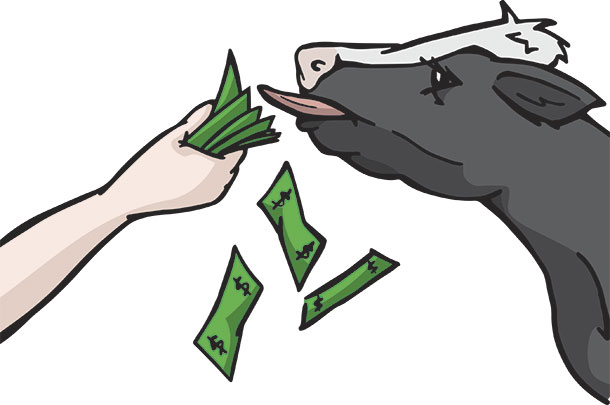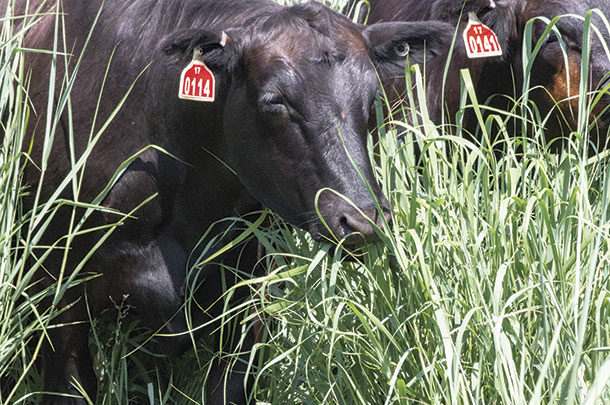Most forages, however, due to their fibrous composition, are less digestible and supply fewer nutrients than other feedstuffs such as grains or commodity byproducts.
In recent years, there has been a renewed interest in increasing the metabolizable energy and protein by improving the quality of forages. While forages cannot supply all the nutrition required for high rates of gain in beef or high levels of milk production, focusing on higher digestibility in many cases will help reduce overall feed costs in an animal agriculture business.
Grasses and legumes, like every other living organism, were put on this earth to grow, mature, reproduce and expire – thus completing a life cycle. At the beginning of their lives, they emerge from seed and derive nutrients from the soil, and start off small and tender. As they grow and mature, they will eventually produce seeds for reproduction.
While all this is happening, the structural and molecular makeup of the plant is constantly changing. Photosynthesis creates sugars and proteins that start off in leaves and stems. As the plant matures, stems must become thicker and stronger to support the weight of the plant. Leaf production in many plants is replaced by flowering (but not in all plants), and the protein and energy is diverted into seed production.
All plants are made up of carbohydrates, proteins, vitamins and minerals. Most plants also have some fats (which technically is a carbohydrate) but, for the most part, has little to do with the quality or digestibility of the plant. Every plant has its own unique combination of carbohydrate fractions that influence its digestibility.
When a plant is young, much of the carbohydrates are in the form of simple sugars, such as glucose or fructose. As the plant matures, the sugars develop into pectins and starches, and eventually into cellulose.
It’s the ongoing development of these cellulose matrices that are responsible for the structure and rigidity of a stem, and the proteins are slowly used up in the process. Rumen microbes have a more difficult time breaking down cellulose molecules, which results in less metabolizable energy going to the animal. In excessively mature plants, cellulose becomes lignin that is very nearly indigestible in an animal’s digestive system.
Forages in the early or mid-vegetative state offer the best nutrition for ruminants. At these stages of growth, the plant – grass or legume – will still have a larger leaf-to-stem ratio, meaning there is more protein to be found in the plant, and the sugars have not been completely converted to cellulose. The more mature a plant becomes, the higher the fiber content in it. The fiber level in all plants is inversely proportional to both protein levels and digestibility.
In the spring of the year, the new growth in pastures is often lush after the winter rains or snows. This is the time when plants will be in the early vegetative stage and be the most nutritious for animals. However, these plants don’t know they’re going to be used for animal feed.
They have only one biological goal, and that is to reproduce and propagate their species. In a very short period of time, grasses and legumes will become overly mature, and the value as animal feed will diminish rapidly.
Terminology describing forage quality has changed over the years, starting with measuring crude protein and crude fiber levels to calculate a total digestible nutrients value, which is still used to indicate a feedstuff’s energy value.
Another calculation based on fiber and protein is the relative feed value, which is also widely used to establish feed quality. More recently, laboratory testing has progressed to determining the rates of neutral detergent fiber (NDF) digestibility for forages along with the undigestible fraction of the NDF.
The measurement of NDF is currently considered the best test for measuring insoluble fiber and predicting rates of passage for forages.
Even though a goal in animal nutrition is to maximize forage intakes, grasses and legumes have high percentages of NDF, which is known to depress feed intakes when high amounts are included in a diet. Decreasing feed intakes results in a direct reduction of metabolizable energy and protein.

Forage testing laboratories can calculate different rates of NDF digestibility – 24-hour, 30-hour and 48-hour – estimating the amount of NDF that would be digested prior to passing from the rumen.
Knowing these values enables nutritionists to estimate the rumen retention of forage, gut fill and how much volatile fatty acids will be produced, and a prediction of energy metabolism, growth rates and milk production. In addition to the NDF digestibilities, labs also have testing for 120- and 240-hour NDF digestibility, which helps define the slow and indigestible pools.
The ultimate goal for determining the digestibility rates of forage NDF is in quantifying both how much feed animals can consume along with how much energy can be expected from the fermentation of the various fiber fractions in the forage.
Ruminant scientists are in agreement there are varying pools of fiber digestibility – a rapidly digestible pool, a slowly digestible pool and an indigestible pool. These forage fiber pools vary from forage to forage and can have a significant impact on forage intakes, forage fermentation and, ultimately, how well animals perform.
The primary purpose of forages should, first and foremost, supply a given level of nutrition to meet a predetermined growth or production requirement. All forages have the potential to provide nutrition to our animals. However, the more fibrous the forage becomes, the less energy it will supply to animals.
The animal – whether it be a cow, sheep, goat or horse – will always tell us if a forage is good or poor based on their performance. But in these days of market volatility, knowing ahead of time the digestibility characteristics of forages will prevent any unwanted surprises that will negatively impact a producer’s revenue. ![]()
PHOTO: Cattle grazing. Photo by David Cooper.
ILLUSTRATION: Illustration by Kristen Phillips.

-
John Hibma
- Forage Product Manager
- Dairyland Seed
- Email John Hibma












